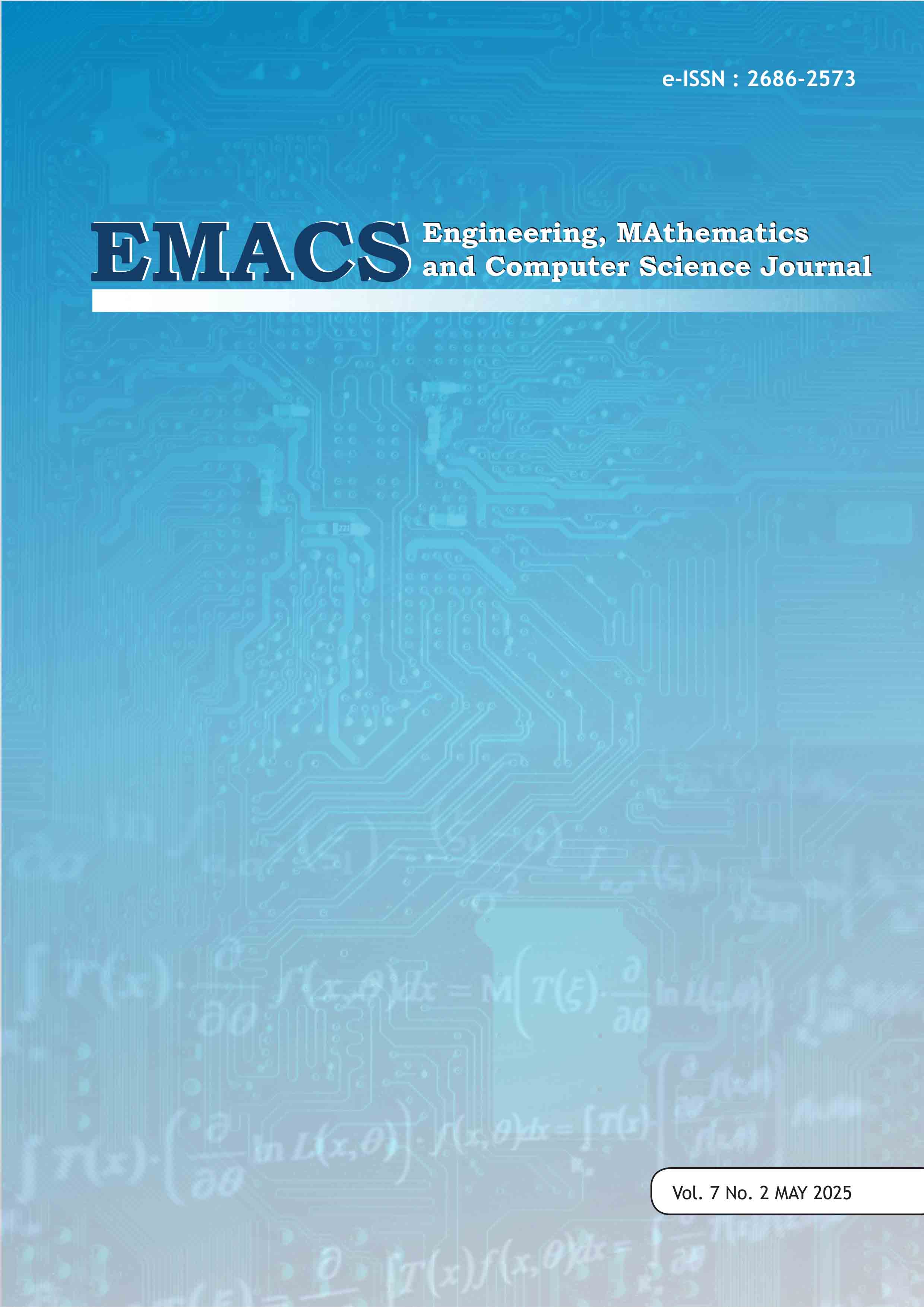Implementation of Microservices Architecture in a Retail Web Application Using Apache Kafka as a Message Broker
DOI:
https://doi.org/10.21512/emacsjournal.v7i2.13932Keywords:
Architecture, Microservices, Apache Kafka, Message Broker, Retail WebAbstract
Web-based applications are often initially developed using monolithic architecture due to its simplicity and ease of deployment. However, as application complexity grows, monolithic systems face critical limitations in scalability, flexibility, and performance. This research applies a microservices architecture to a Retail Web divided into four core services: user, product, transaction, and notification management. Apache Kafka is integrated as a message broker to support asynchronous, real-time communication across services. A total of 2,001 requests were recorded during system testing using Prometheus. The srv_tulityretailaccounts service achieved an average response time of 122.8 ms, and the srv_tulityretailtransactions service maintained 188.1 ms with a 98% success rate. The srv_tulityretailproducts service also demonstrated stable performance with consistently low response times and no error spikes. Meanwhile, the srv_tulityretailnotifications service showed the highest efficiency with an average response time of 28.5 ms, CPU usage at 12.75% (1.53 of 12 cores), and memory usage at 2.07 GB (56.5%) of 3.66 GB. Throughout testing, no service exhibited resource saturation or degradation, even under concurrent load conditions. This confirms the system’s horizontal scalability, where each service can independently scale without impacting others. Overall, the microservices approach has proven effective in enhancing performance, modularity, and production-readiness, while laying a strong foundation for continuous integration, deployment automation, and future feature expansion.
References
Alchuluq, L. M., & Nurzaman, F. (2021). ANALISIS PADA ARSITEKTUR MICROSERVICE UNTUK LAYANAN BISNIS TOKO ONLINE (Vol. 22, Issue 2).
Baboi, M., Iftene, A., & Gîfu, D. (2019). Dynamic microservices to create scalable and fault tolerance architecture. Procedia Computer Science, 159, 1035–1044. https://doi.org/10.1016/j.procs.2019.09.271
Bui, T. (2015). Analysis of Docker Security. http://arxiv.org/abs/1501.02967
Combe, T., Martin, A., & Di Pietro, R. (2016). To Docker or Not to Docker: A Security Perspective. IEEE Cloud Computing, 3(5), 54–62. https://doi.org/10.1109/MCC.2016.100
Dewandra Sapto Prasetyo, & Silfianti, W. (2023). Analisis Perbandingan Pengujian Manual Dan Automation Testing Pada Website E-Commerce. Jurnal Ilmiah Teknik, 2(2), 127–131. https://doi.org/10.56127/juit.v2i2.516
Elgheriani, N. S., Ali, N., & Ahmed, S. (2022). Microservices VS. Monolithic Architechture [The Differential Structure Between Two Architechture] Ministry of Technical and Vocation Education, Libya. http://dx.doi.org/10.47832/2717-8234.12.47
Henrique, G., Oliveira, S., & Duarte, H. (2021). Development of a Message Broker Volume 1 Internship Report in the context of the Masters in Informatics Engineering, Specialization in Engenharia de Software advised by Professor Vasco Pereira and engineer. 1.
Kamisetty, A., Narsina, D., Rodriguez, M., & Kothapalli, S. (2025). Microservices vs . Monoliths : Comparative Analysis for Scalable Software Architecture Design. December 2023. https://doi.org/10.18034/ei.v11i2.734
Leppänen, T. (2021). Data visualization and monitoring with Grafana and Prometheus. Information and Communications Technology, 49.
Miell, I., & Sayers, A. (2019). Docker in Practice, Second Edition. Manning. https://books.google.co.id/books?id=SzgzEAAAQBAJ
Mohammed Daffalla Elradi. (2025). Prometheus & Grafana: A Metrics-focused Monitoring Stack. Journal of Computer Allied Intelligence(JCAI, ISSN: 2584-2676), 3(3), 28-39.
Newman, S. (2021). Building Microservices: Designing Fine-Grained Systems. O’Reilly Media. https://books.google.co.id/books?id=ZvM5EAAAQBAJ
Ranjan, A. (2021). Building Websites with Django: Build and Deploy Professional Websites with Python Programming and the Django Framework (English Edition). Bpb Publications. https://books.google.co.id/books?id=SWEeEAAAQBAJ
Pivotto, J., & Brazil, B. (2023). Prometheus: Up & Running. O’Reilly Media. https://books.google.co.id/books?id=N6-3EAAAQBAJ
Reis, D., Piedade, B., Correia, F. F., Dias, J. P., & Aguiar, A. (2022). Developing Docker and Docker-Compose Specifications: A Developers’ Survey. IEEE Access, 10. https://doi.org/10.1109/ACCESS.2021.3137671
Shethiya, A. S. (2025). Scalability and Performance Optimization in Web Application Development. Journal of Science and Technology Computer Science & Information Technology, 2(1), 1–7. https://creativecommons.org/licenses/by/4.0/deed.en
Tapia, F., Mora, M. ángel, Fuertes, W., Aules, H., Flores, E., & Toulkeridis, T. (2020). From monolithic systems to microservices: A comparative study of performance. Applied Sciences (Switzerland), 10(17). https://doi.org/10.3390/app10175797
Velepucha, V., & Flores, P. (2023). A Survey on Microservices Architecture: Principles, Patterns and Migration Challenges. IEEE Access, 11(August), 88339–88358. https://doi.org/10.1109/ACCESS.2023.3305687
Vincent, W. S. (2022). Django for Professionals. Independently Published. https://books.google.co.id/books?id=0uqjDwAAQBAJ
Oliveira, I. G. (2023) 'Arquitetura escalável de streaming de dados de API utilizando apache Kafka', Universidade Federal do Rio Grande do Norte. https://repositorio.ufrn.br/handle/123456789/53384v
Downloads
Published
How to Cite
Issue
Section
License
Copyright (c) 2025 Stefanus Daeli, Kristian Juri Damai Lase, Yoel Pieter Sumihar

This work is licensed under a Creative Commons Attribution-ShareAlike 4.0 International License.
Authors who publish with this journal agree to the following terms:
- Authors retain copyright and grant the journal right of first publication with the work simultaneously licensed under a Creative Commons Attribution License - Share Alike that allows others to share the work with an acknowledgment of the work's authorship and initial publication in this journal.
- Authors are able to enter into separate, additional contractual arrangements for the non-exclusive distribution of the journal's published version of the work (e.g., post it to an institutional repository or publish it in a book), with an acknowledgment of its initial publication in this journal.
- Authors are permitted and encouraged to post their work online (e.g., in institutional repositories or on their website) prior to and during the submission process, as it can lead to productive exchanges, as well as earlier and greater citation of published work.
USER RIGHTS
All articles published Open Access will be immediately and permanently free for everyone to read and download. We are continuously working with our author communities to select the best choice of license options, currently being defined for this journal as follows: Creative Commons Attribution-Share Alike (CC BY-SA)





